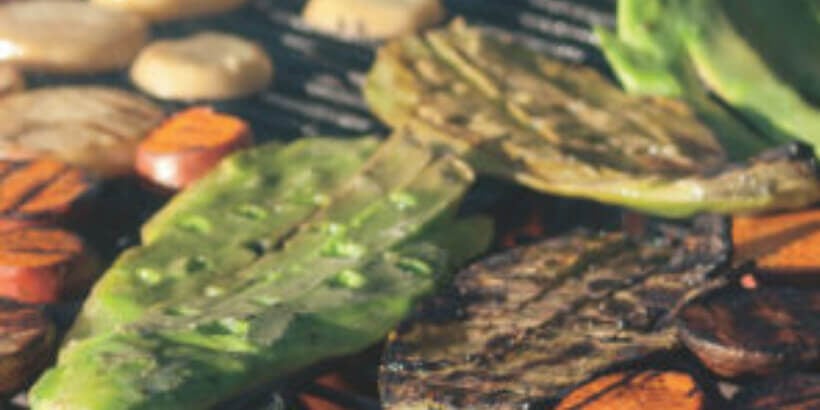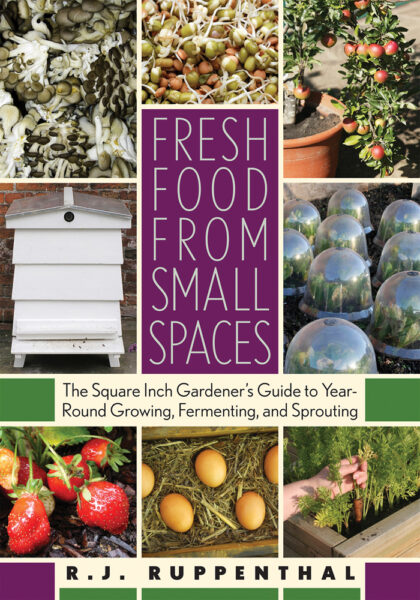RECIPE: Grilled Nopalitos with Herbs and Cotija

Native to Mexico and prevalent throughout the Southwest and California, the prickly pear or nopal cactus, Opuntia ficus-indica, is a stunning drought-hearty landscaping plant, natural barbed-wire fence, and a source of nutritious food – both pads and fruit are edible. Inside the prickly pads lies a cooling, mucilaginous flesh with flavor akin to green beans. In Mexico, “nopalitos” are often prepared grilled and served in tacos, boiled and marinated with garlic, herbs, and crumbly cheese, or scrambled with eggs.
The following is an excerpt fromm The Occidental Arts and Ecology Center Cookbook by Olivia Rathbone. It has been adapted for the web.
Grilled Nopalitos with Herbs and Cotija
Serves 4-6
2 cactus pads, de-spined and peeled
1 clove garlic, crushed
3 tablespoons chopped parsley or cilantro
1 tablespoon chopped fresh oregano
2 tablespoons fresh lemon juice or 1 1/2 tablespoons lime juice
2 tablespoons olive oil
1/3 cup crumbled feta or cotija cheese (optional)
Harvest cactus pads in the late winter or early spring after the rains have saturated deep into the soil and the cactus is fully hydrated and juicy. Choose the young, green tender pads from this year’s growth, not the older callused ones. Handle cactus pads with thick leather gloves – they are armed with long stiff needles as well as inconspicuous little hairs that will insinuate themselves into your skin and clothing if you aren’t careful.
For small, young tender pads, simply peel off the spines with a vegetable peeler. For larger ones, remove the spines using an old-fashioned potato peeler equipped with a sharp nose at the end for digging out the eyes. Dig out each of the follicles at the base of the spines all over the pad. Once the spines have been dug out, rinse the pad and use the peeler or a sharp knife of needed to remove some or all of the outer skin if it seems tough.
Slice the pad in five or so “fingers” that run down the length of the pad but remain intact at the end, resembling the giant slimy green hand of an alien. Brush lightly with olive oil and grill on medium-hot coals until cooked through and slightly charred. Remove from the heat, slice off the strips, and dice. Toss with garlic, herbs, lemon juice, and oil. Top with crumbly cheese such as feta or cotija. Serve in tacos or with scrambled eggs in a breakfast burrito.
Recommended Reads
Recent Articles
Chances are, you’ve seen cattails growing on the edge of your local lake or stream at least once or twice. Instead of just passing these plants, try foraging for and cooking them to create delicious seasonal dishes! The following excerpt is from The New Wildcrafted Cuisine by Pascal Baudar. It has been adapted for the…
Read MoreGarlic mustard: while known as “invasive,” this plant can be consumed in its entirety and has great nutritional value. Plus, the garlic-flavor is a perfect addition to any recipe that calls for mustard! The following are excerpts from Beyond the War on Invasive Species by Tao Orion and The Wild Wisdom of Weeds by Katrina…
Read MoreOh, honeysuckle…how we love thee. If only there was a way to capture the sweet essence of this plant so we could enjoy it more than just in passing. Luckily, foraging and some preparation can help make that happen! Here’s a springtime recipe that tastes exactly like honeysuckle smells. The following excerpt is from Forage,…
Read MoreIntroducing…your new favorite brunch dish! This whole broccoli frittata is packed with fresh, wildcrafted flavors that are bound to help you start your day off on the right foot. The following is an excerpt from The Forager Chef’s Book of Flora by Alan Bergo. It has been adapted for the web. RECIPE: Whole Broccoli Frittata…
Read MoreWondering where to forage for greens this spring? Look no further than hedges, which serve as natural havens for wild greens and herbs! The following is an excerpt from Hedgelands by Christopher Hart. It has been adapted for the web. Food from Hedges: Salads and Greens Let’s start by looking at all the wild foods…
Read More








